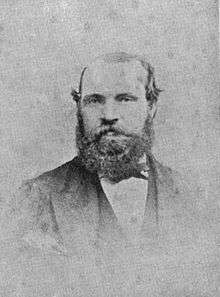Thomas Savin

Thomas Savin (1826-23 July 1889) was a British railway engineer who was the contractor who built many railways in Wales and the Welsh borders from 1857 to 1866. He also in some cases was an investor in such schemes.
Early life
Savin was born in Shropshire at Llwynymaen near Oswestry in 1826.[1] He married in 1852 Eliza Hughes with whom he had two sons who survived him. He initially worked in Oswestry running a mercery business in partnership with Edward Morris, who subsequently purchased then sold the Van lead mines.[2]
Railway contractor
In 1857 Savin formed a partnership with David Davies to build the Vale of Clwyd Railway. The partnership was the principle contractor for many of the lines that became the Cambrian Railways.[1] The partnership was dissolved in 1860.(http://www.london-gazette.co.uk/issues/22525/pages/2751) He also had an interest in or worked on a number of minor railways, including the narrow gauge Corris Railway, the The Kington & Eardisley Railway[3] and the Bishop's Castle Railway[4]
Savin's bankruptcy in 1866 led to the stalling of the Aberystwyth & Welsh Coast Railway which became a part of the Cambrian Railways.
Politics and other interests
David Davies had entered active politics in 1865 when he unsuccessfully fought at Cardiganshire in the General Election. Later that year Savin was briefly mentioned as a possible Liberal candidate for Brecon.[5] Savin served in local politics in Oswestry, to whose borough council he was elected in 1856, became Mayor of the town in 1866, and was alderman from 1871 until his death. He left the Liberal party and became a Conservative because of his support for Benjamin Disraeli's stance over Bulgaria and Turkey against Russia in the 1870s.[2]
Savin served in the volunteer force as lieutenant in the Montgomeryshire Rifles and was captain of the 15th (Oswestry) company of the Shropshire Rifle Volunteers in 1864. He was also a Fellow of the Royal Horticultural Society and Associate of the Institution of Civil Engineers.[2]
Later life
Savin died at his home, Ivy House, in Salop Road, Oswestry on 23 July 1889 and was buried in Oswestry Cemetery, aged 63, on 26 July (Section D, Grave 34). [6]
References
- 1 2 "Biographical details of railway managers".
- 1 2 3 "Oswestry. Death of Mr. Thomas Savin". Shrewsbury Chronicle. 26 July 1889. p. 7.
- ↑ "The Kington & Eardisley Railway".
- ↑ "BBC Shropshire article on the Bishop's Castle Railway".
- ↑ "Editorial". Welshman. 6 October 1865. Retrieved 24 November 2014.
- ↑ Oswestry Cemetery Project website - Find A Grave. (Not to be confused with the international website Find A Grave.)
Bibliography
- Gasquoine, C. P.; The Story of the Cambrian – a biography of a railway; Woodall, Minshall, Thomas & Co, 1922
- Johnson, Peter; An Illustrated History of the Great Western Narrow Gauge; Oxford Publishing Co, 2011 (Savin's involvement with the Corris Railway)
- Williams, Herbert; Davies the Ocean – railway king and coal tycoon; University of Wales Press, 1991